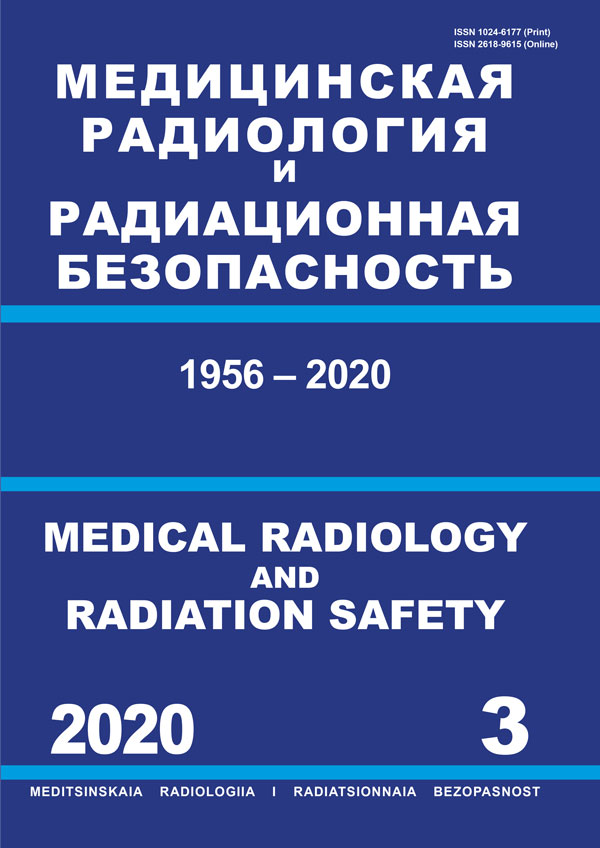UDC 61
CSCSTI 58.35
Russian Library and Bibliographic Classification 22
Russian Trade and Bibliographic Classification 61
BISAC MED080000 Radiology, Radiotherapy & Nuclear Medicine
BISAC SCI058000 Radiation
Purpose: To study the changes in the activity of the liver and blood serum creatine kinase (KK) and the nucleus-nucleolus apparatus of hepatocytes of rats, subjected to the low-intensity electromagnetic radiation of 900 MHz and 25 µW/cm2 energy flux density, typical for a range of mobile phones. Material and methods: The experiments were carried out on white outbred male rats of 6 months of age, weighing 180–200g. The generator Panoramic X1-42 was used as a source of radiation having a frequency of 900 MHz. The activity of CK in the blood serum and liver extracts respectively was determined spectrophotometrically, based on the accumulation of free creatine. Using the extent of the DNA content in rat hepatocytes relative to the accepted standard, the distribution of hepatocytes in ploidy (measured in percentage poins) was detected; so was determined the ratio of eu- and aneuploid cells. Results: It appears that the two-hour single total exposure of rats causes more substantial changes in the activity levels of rats both liver and serum creatine kinase than the total time-wise comparable fractional exposure; while the enzyme exhibits signs of significant adaptation. A decrease in the average DNA content of the nucleus and nucleolus, as well as the average number of nucleolus per nucleus, along with an increase in the number of nucleolus-free nuclei after a single radiofrequency irradiation act indicates certain inhibition of the transcriptional activity of hepatocytes. At the same time, a post-radiation increase of hypodiploid cells, half of which are nucleolus-free hepatocytes, as well as an increase in the number of triploid cells, accompanied by a decrease in the number of tetraploid hepatocytes and the disappearance of hypertetraploid hepatocytes, indicate the incidence of death of a significant number of hepatocytes. Conclusion: The rat liver CK is sensitive to the action of both single low-intensity electromagnetic radiation with a frequency of 900 MHz and that dispersed through fractional exposure: the biological effect of a single exposure is more pronounced. The dynamics of the post-radiation changes occurring in the hepatocyte population upon their single radiofrequency irradiation indicates certain inhibition of the transcriptional activity of the hepatocytes, as well as the incidence of death of a significant number of hepatocytes.
electromagnetic radiation, low intensity, frequency 900 MHz, single and fractional irradiation, creatine kinase, nucleus-nucleolar apparatus, liver, blood serum, rats
1. Grigoriev YuG, Grigoriev OA. Mobile communication and health. Energizdat, Moscow. 2013. 567 p. (In Russ.).
2. Grigoriev YuG. From Electromagnetic Smog to Electromagnetic Chaos. To Evaluating the Hazards of Mobile Communication for Health of the Population. Medical Radiology and Radiation Safety 2018;63(3):28-33 (In Russ.).
3. IARC classifies radiofrequency electromagnetic fields as possibly carcinogenic to humans. Int Agency Res Cancer. 2011;(208):4-6.
4. Warille AA, Altun G, Elamin AA, et al. Skeptical approaches concerning the effect of exposure to electromagnetic fields on brain hormones and enzyme activities. 2010. DOI:https://doi.org/10.1016/j.jmau.2017.09.002
5. Nersesova LS. Role of creatine kinase and its substrates in the central nervous system in norm and in various pathologies. Journal Evol Biochem Fiziol. 2011;47(2):120-7.
6. Malone J, Ullrich R. Novel radiation response genes identified in gene trapped MCF10A mammary epithelial cells. Radiat Res. 2007;167(2):176-84.
7. Aksenov M, Aksenova M, Butterfield DA, Markesbery WR. Oxidative modification of creatine kinase BB in Alzheimer’s disease brain. J Neurochem. 2000;74(6):2520-7.
8. Mozzhukhina TG, Azarksova MV, Litoshenko AYa. Cytofluorimetric analysis of the nuclei of the regenerating rat liver in the long term after x-ray irradiation. Cytology and Genetics. 1998;32(2):49-56. (In Russ.).
9. Shtein GI, Kudryavceva MV, Kudryavcev BN. Changes in the morphometric parameters of the silver-stained nucleoli of rat hepatocytes during liver cirrhosis and in the process of their rehabilitation. Cytology. 1999;43(41):574-80. (In Russ.).
10. Nersesova LS, Gazaryants MG, Mkrtchyan ZS, Meliksetyan GO, Poghosyan LH, Poghosyan SA, et al. Influence of Ionizing Radiation on Enzymatic Activity and State of Nucleus Nucleolar Apparatus in Rat Hepatocytes. Radiation Biology Radioecology. 2013;53(1):55-62. (In Russ.).
11. Petrova TA, Lislova SN. Optimization of Conditions for Determining Creatine kinase Activity by the Colorimetric Method. LSU Bulletin. 1985;(24):88-90. (In Russ.).
12. Maghakyan YuA, Karalova EM. Cytomorphometry of DNA. Yerevan. 1989. (In Russ.).
13. Romeis B. Mikroskopische Technik. München, Leibniz Verlag. 1948.
14. Miller K, Halow J, Koretsky AP. Phosphocreatine protects transgenic mouse liver expressing creatine kinase from hypoxia and ischemia. Am J Physiol. 1993;265(6Pt1):1544-51. DOI:https://doi.org/10.1152/ajpcell.1993.265.6.C1544.
15. Satoh S, Tanaka A, Hatano E, Inomoto T, Iwata S, Kitai T, et al. Energy metabolism and regeneration in transgenic mouse liver expressing creatine kinase after major hepatectomy. Gastroenterology. 1996;110(4):1166-74. PubMed PMID: 8613006.
16. Kerr JF, Winterford CM, Harmon BV. Apoptosis. Its significance in cancer and cancer therapy. Cancer. 1994;73(8): 2013-26. PubMed PMID: 8156506.
17. Capri M, Scarcella E, Bianchi E, Fumelli C, Mesirca P, Agostini C, et al. 1800 MHz radiofrequency (mobile phones, different Global System for Mobile communication modulations) does not affect apoptosis and heat shock protein 70 level in peripheral blood mononuclear cells from young and old donors. Int J Radiat Biol. 2004;80(6):389-97. DOI:https://doi.org/10.1080/09553000410001702346
18. Lantow M, Lupke M, Frahm J, Mattsson MO, Kuster N, Simko M. ROS release and Hsp70 expression after exposure to 1,800 MHz radiofrequency electromagnetic fields in primary human monocytes and lymphocytes. Radiat Environ Biophys. 2006;45(1):55-62. DOI:https://doi.org/10.1007/s00411-006-0038-3.





